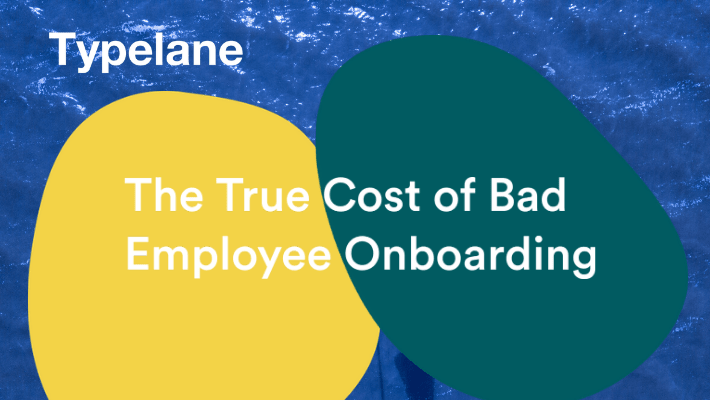The True Cost of A Bad Employee Onboarding


Research shows that a whopping 88% of businesses don’t do a good job while onboarding new employees.
Some businesses don’t believe that a good onboarding process is important, while others simply have no idea what the proper onboarding protocol ought to be.
Regardless of which camp you fall into, if you’re not giving new employees a good onboarding experience, you could be seriously hurting your business.
Read on to learn more about the costs of a bad employee onboarding program. You’ll also learn what you can do to improve your current program and the benefits these improvements will provide your company.
Benefits Of Good Onboarding
Before we dive into the ways how bad onboarding hurts your business, let’s firstly touch on all the reasons why you ought to make good onboarding a priority. Some of the greatest benefits of a strong onboarding program include the following:
- Attract great employees and keep them around
- Engage with the employees from the beginning
- Build trust among new employees
- Help new employees to get aligned with your company culture and vision
- Increase connections among employees
A good onboarding program helps:
- employees to feel engaged and supported
- to improve communication among employees and their superiors
This, in turn, can yield positive results for your company further down the line.
How Much Does Bad Onboarding Cost
Bad onboarding comes with some serious costs for your business. The following are some examples:
Higher Turnover Rates
A report from the Harvard Business Review shows that:
- Nearly 33% of employees start looking for a new job within their first six months ****at their new job
- Another 23% leave before their one-year anniversary.
Most business owners know that it costs much more and takes more time to hire a new employee than to retain a current one. Think of how much money is being lost if more than half of your employees are leaving within a year of being hired.
According to this report, it’s anywhere from 100% – 300% of each employee’s individual salary.
Increased Stress
Think about the last time you started a new job. Do you remember how stressed and anxious you felt going in on your first day?
Your new employees might be feeling that way every day, especially if they weren’t onboarded properly.
When you’re stressed out and struggling to keep up with all the new information being thrown your way, it’s hard to perform to the best of your abilities.
There’s a lot of negativity that stems from employees who have high levels of stress. For example, stressed-out employees are more likely to deal with the following issues:
- Difficulty focusing
- Difficulty managing their time
- Strained interpersonal relationships
- Decreased health
All of these issues may contribute to an employee choosing to leave a position shortly after they were first hired.
Reduced Productivity
If your employees are highly stressed, have trouble focusing, and aren’t able to manage their time well because they’re struggling to remember everything that was thrown at them during their brief onboarding experience, there’s a good chance they’re not going to be very productive.
As you probably know, reduced productivity isn’t good for your business’s bottom line. In fact, low productivity related to stress alone contributes to a loss of $600 per worker per year.
Reduced Engagement
Your employees are more likely to be (and remain) engaged in their work if they have a good onboarding experience.
When your employees are engaged and eager to put their best foot forward, they tend to work better and with more enthusiasm. They also have more positive attitudes and are more inclined to contribute to the improvement of the company, instead of doing the bare minimum to get by.
Disengaged employees also cost your business a lot of money. Just one disengaged employee who earns an average salary may cost you nearly $16,000 per year.
Lost Potential
In a perfect world, every new employee would be able to hit the ground running and perform to their fullest abilities the second they walk in the door at their new job. That’s not the way the world works, though. In fact, in many cases, it takes between eight months and one year for a new employee to start performing to their maximum capabilities.
If the majority of employees are giving up on a job before they reach the one-year mark, there’s a good chance many of them (as well as their supervisors) haven’t even had a chance to see how well they can perform yet. Think of all the potential talent and earnings being lost because new hires aren’t given a chance to get fully acclimated to their positions.
How to Improve Your Onboarding Process
Okay, you can see why it’s important to prioritize good onboarding. How do you make your process better, though? Start by giving these tips a try:
- Focus on getting to know new employees, not just on getting them up to speed
- Help new employees get to know other members of the staff
- Set clear expectations and help employees set goals for themselves
- Offer learning and development opportunities right away to help fill in training gaps
- Arrange for new employees to have one-on-one meetings with their direct supervisors
- Request feedback and ask for advice on how the program can be improved
Start Saving Money Today
Now that you know more about what bad onboarding costs your business, doesn’t it seem like a good idea to start making improvements to your current program?
Keep the tips listed above in mind as you begin making changes or creating a more solidified program.
They’ll help you ensure you’re taking the right approach and handling onboarding in a way that best benefits your new employees and your business as a whole.
Sign up for our newsletter!
Fine-tune your knowledge within on- and offboardings with our monthly newsletters.


